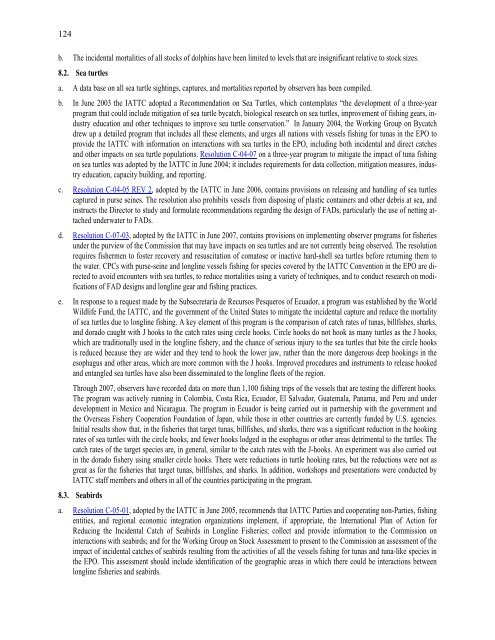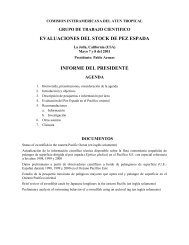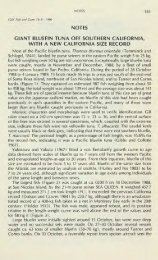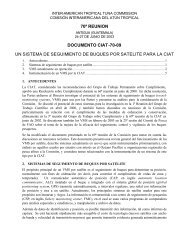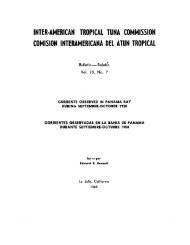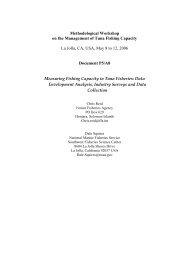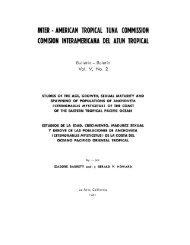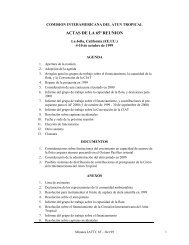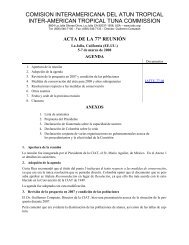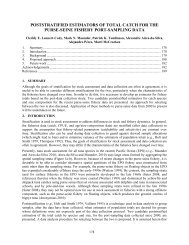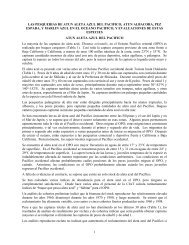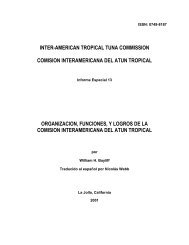INTER-AMERICAN TROPICAL TUNA COMMISSION - Comisión ...
INTER-AMERICAN TROPICAL TUNA COMMISSION - Comisión ...
INTER-AMERICAN TROPICAL TUNA COMMISSION - Comisión ...
- No tags were found...
Create successful ePaper yourself
Turn your PDF publications into a flip-book with our unique Google optimized e-Paper software.
124b. The incidental mortalities of all stocks of dolphins have been limited to levels that are insignificant relative to stock sizes.8.2. Sea turtlesa. A data base on all sea turtle sightings, captures, and mortalities reported by observers has been compiled.b. In June 2003 the IATTC adopted a Recommendation on Sea Turtles, which contemplates “the development of a three-yearprogram that could include mitigation of sea turtle bycatch, biological research on sea turtles, improvement of fishing gears, industryeducation and other techniques to improve sea turtle conservation.” In January 2004, the Working Group on Bycatchdrew up a detailed program that includes all these elements, and urges all nations with vessels fishing for tunas in the EPO toprovide the IATTC with information on interactions with sea turtles in the EPO, including both incidental and direct catchesand other impacts on sea turtle populations. Resolution C-04-07 on a three-year program to mitigate the impact of tuna fishingon sea turtles was adopted by the IATTC in June 2004; it includes requirements for data collection, mitigation measures, industryeducation, capacity building, and reporting.c. Resolution C-04-05 REV 2, adopted by the IATTC in June 2006, contains provisions on releasing and handling of sea turtlescaptured in purse seines. The resolution also prohibits vessels from disposing of plastic containers and other debris at sea, andinstructs the Director to study and formulate recommendations regarding the design of FADs, particularly the use of netting attachedunderwater to FADs.d. Resolution C-07-03, adopted by the IATTC in June 2007, contains provisions on implementing observer programs for fisheriesunder the purview of the Commission that may have impacts on sea turtles and are not currently being observed. The resolutionrequires fishermen to foster recovery and resuscitation of comatose or inactive hard-shell sea turtles before returning them tothe water. CPCs with purse-seine and longline vessels fishing for species covered by the IATTC Convention in the EPO are directedto avoid encounters with sea turtles, to reduce mortalities using a variety of techniques, and to conduct research on modificationsof FAD designs and longline gear and fishing practices.e. In response to a request made by the Subsecretaría de Recursos Pesqueros of Ecuador, a program was established by the WorldWildlife Fund, the IATTC, and the government of the United States to mitigate the incidental capture and reduce the mortalityof sea turtles due to longline fishing. A key element of this program is the comparison of catch rates of tunas, billfishes, sharks,and dorado caught with J hooks to the catch rates using circle hooks. Circle hooks do not hook as many turtles as the J hooks,which are traditionally used in the longline fishery, and the chance of serious injury to the sea turtles that bite the circle hooksis reduced because they are wider and they tend to hook the lower jaw, rather than the more dangerous deep hookings in theesophagus and other areas, which are more common with the J hooks. Improved procedures and instruments to release hookedand entangled sea turtles have also been disseminated to the longline fleets of the region.Through 2007, observers have recorded data on more than 1,100 fishing trips of the vessels that are testing the different hooks.The program was actively running in Colombia, Costa Rica, Ecuador, El Salvador, Guatemala, Panama, and Peru and underdevelopment in Mexico and Nicaragua. The program in Ecuador is being carried out in partnership with the government andthe Overseas Fishery Cooperation Foundation of Japan, while those in other countries are currently funded by U.S. agencies.Initial results show that, in the fisheries that target tunas, billfishes, and sharks, there was a significant reduction in the hookingrates of sea turtles with the circle hooks, and fewer hooks lodged in the esophagus or other areas detrimental to the turtles. Thecatch rates of the target species are, in general, similar to the catch rates with the J-hooks. An experiment was also carried outin the dorado fishery using smaller circle hooks. There were reductions in turtle hooking rates, but the reductions were not asgreat as for the fisheries that target tunas, billfishes, and sharks. In addition, workshops and presentations were conducted byIATTC staff members and others in all of the countries participating in the program.8.3. Seabirdsa. Resolution C-05-01, adopted by the IATTC in June 2005, recommends that IATTC Parties and cooperating non-Parties, fishingentities, and regional economic integration organizations implement, if appropriate, the International Plan of Action forReducing the Incidental Catch of Seabirds in Longline Fisheries; collect and provide information to the Commission oninteractions with seabirds; and for the Working Group on Stock Assessment to present to the Commission an assessment of theimpact of incidental catches of seabirds resulting from the activities of all the vessels fishing for tunas and tuna-like species inthe EPO. This assessment should include identification of the geographic areas in which there could be interactions betweenlongline fisheries and seabirds.


